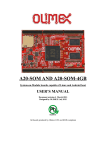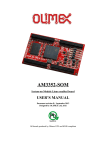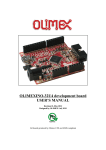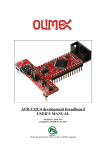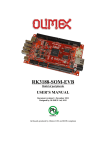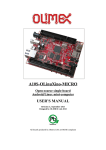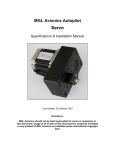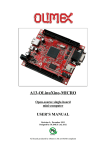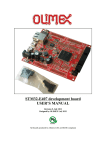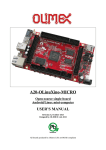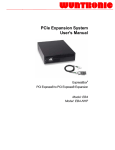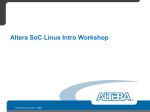Download RK3188-SOM AND RK3188-SOM-4GB
Transcript
RK3188-SOM AND RK3188-SOM-4GB System-on-Module boards capable of Linux and Android boot USER’S MANUAL Document revision B, November 2015 Designed by OLIMEX Ltd, 2015 All boards produced by Olimex LTD are ROHS compliant OLIMEX© 2015 RK3188-SOM user's manual DISCLAIMER © 2015 Olimex Ltd. Olimex®, logo and combinations thereof, are registered trademarks of Olimex Ltd. Other product names may be trademarks of others and the rights belong to their respective owners. The information in this document is provided in connection with Olimex products. No license, express or implied or otherwise, to any intellectual property right is granted by this document or in connection with the sale of Olimex products. The hardware designs of A20-SOM and A20-SOM-4GB development boards are considered intellectual property to Olimex. Hardware schematics are shared with the customers. However, the board layout files are considered copyright material and would not be shared. The hardware design of RK3188-SOM-EVB development board is considered open source hardware. The source design files are published online and accessible by everyone. The software is released under GPL. It is possible that the pictures in this manual differ from the latest revision of the board. The product described in this document is subject to continuous development and improvements. All particulars of the product and its use contained in this document are given by OLIMEX in good faith. However all warranties implied or expressed including but not limited to implied warranties of merchantability or fitness for purpose are excluded. This document is intended only to assist the reader in the use of the product. OLIMEX Ltd. shall not be liable for any loss or damage arising from the use of any information in this document or any error or omission in such information or any incorrect use of the product. This evaluation board/kit is intended for use for engineering development, demonstration, or evaluation purposes only and is not considered by OLIMEX to be a finished end-product fit for general consumer use. Persons handling the product must have electronics training and observe good engineering practice standards. As such, the goods being provided are not intended to be complete in terms of required design-, marketing-, and/or manufacturing-related protective considerations, including product safety and environmental measures typically found in end products that incorporate such semiconductor components or circuit boards. Olimex currently deals with a variety of customers for products, and therefore our arrangement with the user is not exclusive. Olimex assumes no liability for applications assistance, customer product design, software performance, or infringement of patents or services described herein. THERE IS NO WARRANTY FOR THE DESIGN MATERIALS AND THE COMPONENTS USED TO CREATE RK3188-SOM, RK3188-SOM-4GB AND RK3188-SOM-EVB. THEY ARE CONSIDERED SUITABLE ONLY FOR RK3188-SOM, RK3188-SOM-4GB AND RK3188-SOM-EVB, RESPECTIVELY. Page 2 of 39 OLIMEX© 2015 RK3188-SOM user's manual Table of Contents DISCLAIMER............................................................................................................. 2 CHAPTER 1: OVERVIEW........................................................................................5 1. Introduction to the chapter.......................................................................................................5 1.1 Introduction to SOM (System-On-a-Module).......................................................................5 1.2 Target market of the board.....................................................................................................6 1.3 Features of RK3188-SOM.......................................................................................................6 1.4 Board variants..........................................................................................................................7 1.5 Board versions used in the manual........................................................................................ 7 1.6 Document organization........................................................................................................... 7 CHAPTER 2: BOARD DESCRIPTION................................................................... 8 2. Introduction to the chapter.......................................................................................................8 2.1 Layout (top view).....................................................................................................................8 2.2 Layout (bottom view)...............................................................................................................9 CHAPTER 3: SETTING UP THE RK3188-SOM BOARD.................................. 10 3. Introduction to the chapter.....................................................................................................10 3.1 Electrostatic and electrical polarity warnings.....................................................................10 3.2 Requirements......................................................................................................................... 10 3.3 Preparing the OS to boot.......................................................................................................11 3.3.1 Should I boot from the microSD card or from the NAND memory?...................................................... 11 3.3.2 Preparing a Debian microSD card..............................................................................................................12 3.3.3 Uploading a Debian image to the NAND...................................................................................................12 3.4 Powering the board................................................................................................................14 3.4.1 Stand-alone powering...................................................................................................................................14 3.4.2 Mounted powering....................................................................................................................................... 15 3.5 Button functions.....................................................................................................................16 3.6 Interacting with the board....................................................................................................16 3.7 Expanding the Debian file system space..............................................................................17 3.8 Changing the default image resolution................................................................................17 3.9 Connecting and calibrating a display...................................................................................19 3.9.1 Android calibration......................................................................................................................................19 3.9.2 Debian calibration........................................................................................................................................20 3.10 Software support..................................................................................................................20 CHAPTER 4: THE RK3188 PROCESSOR........................................................... 21 4. Introduction to the chapter.....................................................................................................21 4.1 The processor......................................................................................................................... 21 4.2 Block diagram........................................................................................................................ 22 CHAPTER 5: CONTROL CIRCUITY................................................................... 23 5. Introduction to the chapter.....................................................................................................23 5.1 Reset........................................................................................................................................23 5.2 Clocks......................................................................................................................................23 5.3 Power supply circuit.............................................................................................................. 23 Page 3 of 39 OLIMEX© 2015 RK3188-SOM user's manual CHAPTER 6: CONNECTORS AND PINOUT......................................................24 6. Introduction to the chapter.....................................................................................................24 6.1 Communication with RK3188-SOM in Linux.................................................................... 24 6.2 UART_DEBUG header......................................................................................................... 24 6.3 MicroSD card connector....................................................................................................... 25 6.3.1 SD/MMC slot................................................................................................................................................26 6.4 GPIO connectors....................................................................................................................27 6.4.1 GPIO-1 (General Purpose Input/Output) 40pin connector..................................................................... 28 6.4.2 GPIO-2 (General Purpose Input/Output) 40pin connector..................................................................... 29 6.4.3 GPIO-3 (General Purpose Input/Output) 40pin connector..................................................................... 30 6.4.4 GPIO-4 (General Purpose Input/Output) 40pin connector..................................................................... 31 6.5 LCD_CON 40pin connector..................................................................................................32 6.6 Jumper description................................................................................................................33 6.7 Additional hardware components........................................................................................ 33 CHAPTER 7: SCHEMATICS..................................................................................34 7. Introduction to the chapter.....................................................................................................34 7.1 Eagle schematic......................................................................................................................34 7.2 General physical dimensions.................................................................................................34 CHAPTER 8: REVISION HISTORY AND SUPPORT........................................ 35 8. Introduction to the chapter.....................................................................................................35 8.1 Document revision................................................................................................................. 35 8.2 Board revision........................................................................................................................ 35 8.3 Useful web links..................................................................................................................... 35 8.4 How to purchase?...................................................................................................................36 8.5 Order codes.............................................................................................................................36 8.6 Frequently asked questions...................................................................................................37 8.7 Product support..................................................................................................................... 39 Page 4 of 39 OLIMEX© 2015 RK3188-SOM user's manual CHAPTER 1: OVERVIEW 1. Introduction to the chapter Thank you for choosing this single board computer from Olimex! This document provides a user’s guide for the RK3188-SOM and RK3188-SOM-4GB boards. As an overview, this chapter gives the scope of this document and lists the board’s features. The document’s organization is then detailed. The RK3188-SOM development board enables code development of applications running on the RK3188 microcontroller, manufactured by Rockchip from China. The RK3188-SOM is typically used together with RK3188-SOM-EVB which features most of the peripherals and connectors needed for full evaluation and utilization of the RK3188 processor. The hardware design of RK3188-SOM development board is considered intellectual property to Olimex. The hardware layout design files are considered copyright material and would not be distributed. The original schematics, however, are distributed in popular file format. RK3188-SOM-EVB board is an open-source, open-hardware project and all documentation is available to the customer. The software support for both boards is open-source and released under GPL license. 1.1 Introduction to SOM (System-On-a-Module) OLIMEX System-on-Module (SOM) boards are powerful Linux-capable boards. They follow a low-cost modular design which allows rapid product development. Each of these boards has two parts – a main part which nests the processor, the memory and the power control unit and the peripheral part which contains the USB ports, the video output and most of the connectors. SOM designs are targeted at customers who want to apply custom modifications and own solutions based on a specific processor without having to deal with multi layer PCBs with controlled impedance and BGA assembly. This makes it possible to create simple boards (that might be manufactured by your local board manufacturer) containing only the peripherals you need with the dimensions and shape suitable for your specific solution. Both the main part and the peripheral part of the SOM system have support in the official Android and Debian images distributed by Olimex and maintained by Olimex and the Linux community. These images are typically available at the wiki articles of the boards. The peripheral part of the SOM design is considered Open Source HardWare (OSHW) and the customer has access to the board source files that we used to manufacture it. The part of the design that has the main microcontroller is considered proprietary design and design files would not be shared. If you are looking for open source design of the processors used please check the OLinuXino boards. OLinuXino board designs are fully open source but harder to implement in own solutions and require more of a hardware experience to do so. Nevertheless, OLinuXino boards are pretty good choice for evaluating the capabilities of the embedded processors. Page 5 of 39 OLIMEX© 2015 RK3188-SOM user's manual 1.2 Target market of the board Using the RK3188-SOM as a stand-alone development board would be more suitable for users with some hardware experience or people already familiar with other single-board Linux boards and designs. As mentioned in the previous chapter the board is meant to be implemented in a hardware design. It is highly recommended to use RK3188-SOM with RK3188-SOM-EVB initially, unless you have previous experience with SOM or OLinuXino boards manufactured by OLIMEX. Note that in the OLIMEX web-shop the product named “RK3188-SOM-EVB” includes the main board named “RK3188-SOM-4GB”. RK3188-SOM might be is used altogether with RK3188-SOM-EVB. In that case, the board's target market widens drastically – the combination is suitable for embedded programming enthusiasts, Linux and Android gadget fans (they can just use the board as a media center or fully functional Linux-PC, for instance) and also professionals (since its low cost makes it very good solution for application-orientated embedded systems). The reason for this alteration is the additional hardware that RK3188-SOM-EVB – it provides direct HDMI output and easier ways to connect peripherals to the board. Generally, the processor's features become easier to access. In which cases a stand-alone RK3188-SOM (without RK3188-SOM-EVB) board might not be suitable for you: 1. If you are a beginner with single-board Linux computers 2. If you are an OSHW purist 3. If you are looking for more straight-forward software development and you are not going to implement the RK3188-SOM in own hardware products In the cases above, it might be a better idea to take a look at the OLinuXino boards (like A20OLinuXino-MICRO or A20-OLiuXino-LIME2). 1.3 Features of RK3188-SOM The RK3188-SOM board has the following set of features: • • • • • • • • • • • • Rockchip RK3188 quad core Cortex-A9 processor, each core typically running at 1.6GHz 1GB DDR3 memory 4GB NAND flash memory (available only in the 4GB version of the board) Debian Linux already loaded in the NAND (only in the 4GB version of the board) Integrated power management unit AC8846 PMU IC MicroSD card connector UART debug pins exposed 3 × user-programmable LEDs Power LED 3 × buttons – POWER, RESET, RECOVERY 5 connectors x 40 pin 0.05" step Dimensions: (3.2×1.8)'' ~ (81×56)mm Page 6 of 39 OLIMEX© 2015 RK3188-SOM user's manual 1.4 Board variants There are two major board variants named: RK3188-SOM and RK3188-SOM-4GB. The 4GB version has built-in NAND memory that allows the storage of an operating system without the need of a SD card. The 4GB version comes with already programmed and ready-to-use Debian Linux image. Other SOM boards that might be compared to functionality are: the well-supported A20-SOM, and the new BeagleBone-inspired AM3352-SOM. Another Olimex board with close characteristics is A13-SOM board. It is much cheaper and smaller. It heats less and consumes less power. However, it features a generation older processor and lesser amount of RAM memory, making it less desirable for heavy computations (for instance, high resolution video decoding and encoding). Yet, for simpler command-line tasks it might be the most suitable choice. 1.5 Board versions used in the manual The documents follows the hardware layout of RK3188-SOM board revision C. RK3188-SOM-EVB revision C peripheral board was used while writing this document. Different board revisions might have different features or settings. It is possible that parts of this document do not apply to all board revisions. 1.6 Document organization Each section in this document covers a separate topic, organized as follows: – – – – – – – – Chapter 1 is an overview of the board usage and features Chapter 2 contains the general board diagram and layout Chapter 3 provides a guide for quickly setting up the board and software notes Chapter 4 describes the component that is the heart of the board: the Rockchip RK3188 processor Chapter 5 is an explanation of the control circuitry associated with the microcontroller Chapter 6 covers the connector pinout, peripherals and jumper description Chapter 7 provides the schematics and the dimensions of the board Chapter 8 contains the revision history, useful links and support information Page 7 of 39 OLIMEX© 2015 RK3188-SOM user's manual CHAPTER 2: BOARD DESCRIPTION 2. Introduction to the chapter Here you get acquainted with the main parts of the board. Note the names used on the board might differ from the names used below to describe them. For the actual names check the RK3188-SOM board itself. 2.1 Layout (top view) The picture below shows the top side of the board and highlights the most important parts: Page 8 of 39 OLIMEX© 2015 RK3188-SOM user's manual 2.2 Layout (bottom view) The picture below shows the bottom side of the board and highlights the most important parts: GPIO-1, GPIO-2, GPIO-3, GPIO-4, and LCD_CON are female connectors with 0.01'' step. They are used to attach RK3188-SOM to RK3188-SOM-EVB (or to your custom shield of peripherals). Page 9 of 39 OLIMEX© 2015 RK3188-SOM user's manual CHAPTER 3: SETTING UP THE RK3188-SOM BOARD 3. Introduction to the chapter This section helps you set up the SOM development board for the first time. Please consider first the electrostatic warning to avoid damaging the board, then discover the hardware and software required to operate the board. The procedure to power up the board is given, and a description of the default board behavior is detailed. 3.1 Electrostatic and electrical polarity warnings RK3188-SOM boards are shipped in a protective anti-static package. The board must not be exposed to high electrostatic potentials. A grounding strap or similar protective device should be worn when handling the board. Avoid touching the component pins or any other metallic element. Ensure that your development board gets attached to properly working hardware. If this is not possible please use isolators (like USB-ISO) to save your development board from potential over voltage. If you connect other electrical devices to the SOM board make sure that they have equal electrical polarity. For example, when you connect a serial cable connected between a PC and the board's DEBUG port it is a good idea to have them both connected to the same electrical source (to the same utility power socket). In rare cases different polarity might cause hardware damage to the board. 3.2 Requirements In order to set up the RK3188-SOM board optimally one or more additional items may be needed. They might be generally placed in two categories: Required – items that are needed in order to achieve minimum functionality; Recommended – items that is good to have in order to be able to interact with the most important of the features of the board; Note that if RK3188-SOM is mounted on RK3188-SOM-EVB – the requirements would be different! The requirements below are for a stand-alone use of RK3188-SOM. Refer to RK3188SOM-EVB's user's manual for adjusted requirements. Required items: - 5V-external power supply with proper connectors – RK3188-SOM has no power jack, only powering pins (+5V, GND) - Output device – USB-SERIAL-CABLE-F + personal computer with serial terminal program – RK3188-SOM lacks other options for debugging – you would need a serial cable that can work at the CMOS levels of the board's signals - SD card with compatible image – if you have the board version with NO additional NAND Page 10 of 39 OLIMEX© 2015 RK3188-SOM user's manual memory you will need it to use one of the images available. If you decide to use Debian you would also need a card. Official Android and Debian images are available at the wiki article for the board. Recommended items: - RK3188-SOM-EVB – reference design of a 2-layer board for RK3188-SOM that adds HDMI, 100MB Ethernet, USB-OTG and 4x USB HS/FS/LS hosts, RTC with backup battery. The RK3188SOM-EVB board also adapts the 0.05'' step GPIO headers to 0.1'' step headers so you can easily attach an LCD or UEXT module. Its hardware design is open source and available as Eagle CAD files, so everyone can modify and tailor it according to the specific needs. Some of the above-suggested items can be purchased by Olimex, for instance: USB-SERIAL-CABLE-F – female USB serial console cable – provides the easiest way of debugging RK3188-SOM-DEBIAN-SD – a tested, class 10 micro SD card suitable for RK3188-SOM with the latest (by the time of leaving Olimex facilities) official Debian Linux release 3.3 Preparing the OS to boot Currently, we provide only one official image for RK3188-SOM board – a Debian image that has to be downloaded to a microSD card. There is an extra Debian image suitable only for the NAND memory of RK3188-SOM-4GB. This means that if you have RK3188-SOM-4GB you can chose whether you want to boot from a microSD card or from the 4GB NAND memory. Step-by-step instructions on how the images were prepared (and files required) are available at the wiki article here: https://www.olimex.com/wiki/RK3188-SOM 3.3.1 Should I boot from the microSD card or from the NAND memory? Generally, booting from microSD card is faster and safer. However, in specific cases booting from NAND might be the better decision. Consider the below comparison when deciding where to boot from. Using NAND is better than using microSD card when: 1. You are aiming for minimal power consumption; 2. there is no microSD card connector, no external connections are allowed or microSD card is not preferred storage medium; 3. for academic reasons. Using NAND is worse than using microSD card because: 1. It is slower than a class 10 microSD card; 2. it is harder to make a backup; 3. in case of a problem with the file system – the device would not boot and the recovery (of your data) would be nearly impossible. Page 11 of 39 OLIMEX© 2015 RK3188-SOM user's manual 3.3.2 Preparing a Debian microSD card In order to download an official Linux image to a microSD card under Windows you can use Win32 Disk Imager: 1. Download the latest official image suitable for a microSD card from the wiki article of the board 2. Download Win32 Disk Imager from this link. 3. Insert card in your microSD card reader 4. Start program 5. Select the image 6. Click "write" Under Linux you can write the image image to the card with dd utility. This is how it can be done: Let's say the name of the image is "debian_2g.img". It would be downloaded to the microSD card connected to a Linux machine using one of the following commands: dd bs=4M oflag=sync if=debian_2g.img of=/dev/sdX or cp debian_2g.img /dev/sdX where /dev/sdX is the uSD card as listed by the Linux. 3.3.3 Uploading a Debian image to the NAND RK3188-SOM-4GB comes with Debian already loaded on the NAND memory. No need to perform this operation initially. In case the image available on the NAND got corrupted or erased you can recover it the following way: 1. You need to download the software tools for your computer provided by Rockchip. If you use Windows download “Rockchip Batch Tool”. If you use Linux use either rkflashkit or upgrade_tool. These are the tools that I recommend but there are a lot of tools available. If you are a Windows user get the Rockchip batch tool from here: Rockchip Batch Tool For Windows: 2. Install the drivers that allows your computer to recognize the board (when the last is already set in bootloader mode) connected to it. The installer is called "Rockchip Driver Assistant" – download it here: Rockchip Driver Assistant 3. Download and extract the latest image suitable for the NAND from our wiki. The place in the wiki to look for a torrent of the latest image is this sub-chapter: Debian for NAND memory 4. Enter bootloader mode with the board to be able to establish connection between the board and the software provided by Rockchip. You would also need a mini USB cable. To enter bootloader mode you need to press and hold down the recovery button before powering the board (then connect Page 12 of 39 OLIMEX© 2015 RK3188-SOM user's manual the board to the PC via the mini USB cable). After the board is powered you can release the button. At this point, if the drivers from step 2 are properly installed you should see the device listed in “Windows Device Manager” as Rockusb Device: 5. Start the tool for uploading the firmware and point it to the extracted image. 6. Click button "Upgrade" and wait till the upgrade and the verification are completed: Page 13 of 39 OLIMEX© 2015 RK3188-SOM user's manual 7. Test with a serial cable if the board boots fine. Test the commands shown below: 3.4 Powering the board The powering requirements of the RK3188-SOM are different depending on whether you use it in stand-alone mode or mounted atop RK3188-SOM-EVB. The sub-chapters below deal with both scenarios. 3.4.1 Stand-alone powering If you use the board in stand-alone mode (e.g. it is neither attached to RK3188-SOM-EVB nor to any other board of peripherals) there are fewer options for powering it. Consider that you might need additional cables or connectors. You have the following options of powering the board: 1. provide +5V DC voltage to pin “5.0V” at the DEBUG-UART header; connect ground to pin “GND” of the same header 2. provide +5V DC voltage to either pin 1 of the LCD_CON header, or pin 1 of the GPIO-1 header; connect ground to pin 2 of the LCD_CON, or pin 2 of GPIO-1. IMPORTANT – provide power supply to only one of the mentioned pins, providing 5V to pin 1 of both headers simultaneously would lead to a short-circuit! *3. provide +5V driven by any USB to pin 1 of GPIO-4 (signal “+5V_OTG_PWR”); connect ground to pin 2 of GPIO-4 * Note that by default the +5V_OTG_PWR line is disconnected from the main processor. In case Page 14 of 39 OLIMEX© 2015 RK3188-SOM user's manual you need to use it inspect the schematics for components D1, R38 and R39. It is just and optional power line that would require additional hardware components, should you choose to use it. The default way of powering the board is using external power supply. In that case you would need to provide +5V DC at the “5.0V” pin of the DEBUG-UART connector. You would also need to connect the GND line of you supply to one of the GND pins of the same connector. The minimum power that your supply should be able to prove is 2.5W (equivalent of 0.5A of current at 5V of voltage). Note that there is no standard jack for the powering circuit but you might add own DC power jack. Do not provide AC voltage to the RK3188-SOM board! Do not provide more than 5V of voltage directly to the RK3188-SOM board! Providing 12V would instantly cause permanent hardware damage! Sometimes when starting Android it is possible the board to enter battery save mode even before booting fully. Especially, if you have turned off the board without quick boot mode enabled. In this case you should press the PWR button for at least 5 seconds which would allow the board to start. Furthermore, if the board has entered power-down state you can bring it back without restart using either REC or POWER button. 3.4.2 Mounted powering Typically, RK3188-SOM gets evaluated when mounted atop RK3188-SOM-EVB. In this case the former is powered via the latter. The power line, altogether with a number of other important processor lines, is transferred via the 40-pin headers. RK3188-SOM receives power from RK3188SOM-EVB, but what are the requirements to power RK3188-SOM-EVB? You need to provide 6V to 16V DC voltage to the power jack (named PWR) of RK3188-SOM-EVB board. The DC barrel jack has 2.0mm inner pin and 6.3mm hole. More information about the exact component might be found here: https://www.olimex.com/wiki/PWRJACK Do not provide AC voltage to the RK3188-SOM-EVB board! Do not provide more than 16V of voltage to the RK3188-SOM-EVB board! The typical consumption of RK3188-SOM-EVB + RK3188-SOM is around 0.15A @ 10V but might reach peaks up to 0.25A @ 10V during initial boot. These values were measured without anything else connected to the board (e.g. no keyboard, no mouse, no LCD display, etc). For the European customers, we also stock and sell basic power supply adapters compatible with the power jack. The board can be powered by a personal computer using the USB_OTG connector. However, the USB standards limit the maximum power available at a personal computer's USB port. Thus, powering the board via the USB_OTG port is not recommended. Especially if you are using extra peripherals (like LCD display, keyboard, mouse, etc.). Note that it is normal that when the board is powered some integrated circuits might appear hotter than others. This is perfectly normal for some electronic components – for instance – the voltage regulators and the main processor. Page 15 of 39 OLIMEX© 2015 RK3188-SOM user's manual 3.5 Button functions The three buttons listed bellow are supported under both Android and Debian: POWER – power button – used to perform software turn off, software turn on – has to be held down for at least 5 seconds to perform each action REC – recovery button – used to wake up the board from sleep RST – reset button – used for hardware reset of the board – before using it, please refer to the note below It is always recommended to perform a soft “turn off” of the board. If that is not possible then please hold POWER button down for a few seconds to “turn off the board”. Then you are free to remove the power supply. If you disconnect the power supply (either the USB or the power jack) before turning off the board you may corrupt your SD card. If your board has NAND memory you can corrupt the image located on the NAND memory. 3.6 Interacting with the board The typical and recommended way of interacting with RK3188-SOM board is via a serial cable connected between the UART-DEBUG header and a personal computer. You would probably need a cable suitable for such a connection due to the fact that most personal computers lack a serial port nowadays. Even if you have serial port you should respect the CMOS levels of the board which are incompatible with the TTL levels of your computer. We distribute a ready-to-use plug-and-play cable – it is called USB-SERIAL-CABLE-F. Even if you already have such a cable or you decide to purchase it elsewhere it is advisable to check this product page for a reference: https://www.olimex.com/Products/Components/Cables/USB-Serial-Cable/USB-Serial-Cable-F/ You need to connect the cable to the UART-DEBUG pins as follows: RX line to UART0-TX pin; TX line to UART0-RX pin; GND to GND. Make sure that the serial cable is connected to your personal computer and recognized properly after driver installation. After the hardware connection is established, open a terminal program on the serial (COM) port which the cable is associated with. The typical baud rate is 115200, the rest of the settings should be left as per default. After everything else is set, you would need to power the board as explained in “3.3 Powering the board”. In the command line interface of the official Debian images you are automatically logged as root. The default superuser username/password combination in the GUI (XFCE4) of the official images is: olimex/olimex. If RK3188-SOM is attached to RK3188-SOM-EVB, in addition to the serial communication, you might also use one or more of the following mediums to interact with the board: 1. a monitor via HDMI connector 2. SSH with a remote computer via LAN connector 3 a display via LCD_CON connector Page 16 of 39 OLIMEX© 2015 RK3188-SOM user's manual Refer to the RK3188-SOM-EVB's datasheet for more information on each connection. Note that not all interface options are available for all images. Furthermore, some of the ways of interaction are not suitable for Android OS. The official Debian image should give you the most possible options of interfacing the board! Using HDMI, LCD_CON or LAN might require additional configurations. Furthermore, it is possible to corrupt the output settings over those interfaces and, thus, lose the output. In such cases, you can always use the serial cable USB-SERIAL-CABLE-F as a reliable way to establish connection to the board. 3.7 Expanding the Debian file system space The provided official Debian images have constant size but you may want to use a bigger microSD card. In case you don't know how to expand the file system space you can use the built-in shell script for this task. This way you can take advantage of the whole volume of your microSD card. Type in the command prompt: ./resize_sd.sh /dev/mmcblk0 1 After that you need to reboot the board with: reboot You can find the name given to the microSD card and its partitions using: fdisk -l 3.8 Changing the default image resolution The method for changing the output video resolutions varies whether you are using Android or Debian. To ease the process of changing the resolution we have compiled a number of Android images for the Android users (with hard-coded video output settings). Alternatively, for Debian Linux users, we have provided a shell script that can be executed in order to set preferred video output and resolution. For Android that you boot from the NAND memory you would need an image suitable for the specific resolution. Download locations to such images might be found at the wiki article for the RK3188 board here: https://www.olimex.com/wiki/RK3188-SOM. For Linux Debian you would need to execute a shell script to be able to change the resolution. It is very good idea to use a serial cable for connection to the board from a personal computer since in this case you are not dependent on the current video output resolution (a cable like USB-SERIALCABLE-F). When the board boots type: Page 17 of 39 OLIMEX© 2015 RK3188-SOM user's manual ./change_display.sh Then you would be asked for confirmation. Type: yes At this point you would be asked if you boot the Debian from a microSD card or from the NAND memory of the board. The script covers both cases. By default you would be booting from microSD so write “0”. The supported resolutions that you can select are: HDMI OUTPUT LCD OUTPUT [0] HDMI 480p [3] LCD 4.3 inch [1] HDMI 720p [4] LCD 7 inch [2] HDMI 1080p [5] LCD 10 inch *HDMI 720p is the default video output resolution in the Debian image. Press the number that corresponds to the desired video ouput resolution. At this point you would be asked if you wish to reboot the board. The video output changes would be applied after a reboot, so it is advised to reboot the board at this point. The whole interface of the script is shown in the picture below: In case you need a custom video output resolution you would need to edit the kernel. There are no configuration files that can be easily edited to achieve the desired video output. Page 18 of 39 OLIMEX© 2015 RK3188-SOM user's manual 3.9 Connecting and calibrating a display One of the ways to interact with the board is via an external display (with or without touchscreen component). However, there is only a 40-pin female connector LCD_CON with a 0.05'' step. Unlike other OLIMEX Allwinner boards, the RK3188-SOM lacks a row of pins that allows the user to connect a display out-of-the-box. The board's LCD_CON connector is female and has a smaller 0.05'' step. This means that if you use a display made by OLIMEX, you would need additional 2×20 MALE-MALE 0.05'' header to convert the female connector to male. The 0.05'' headers are somehow hard to find so we sell them here: 0.05'' step connectors. You would also need a compatible cable between the board and the display. The current generation of OLIMEX-made displays have both 0.1'' and 0.05'' step connectors. The cable used for connection depends on the specific board you are using and more specifically it depends on the pitch of the LCD connector of the board. We have two cables – both 40-pins ones but one for the bigger pitch (0.1'') and the other for the smaller one (0.05''). Each of the displays listed in the table above has two connectors suitable for both cables: CABLE-IDC40-15cm – 15cm long cable suitable for 0.1'' step connectors – Product page CABLE-40-40-10CM – 10cm long cable suitable for 0.05'' step connectors – Product page The displays recommended for the board at the moment of writing might be found in the table below: Display name LCD-OlinuXino-4.3TS LCD-OLinuXino-7 LCD-OLinuXino-7TS LCD-OLinuXino-10 LCD-OLinuXino-10TS Size of display in inches 4.3 7 7 10.1 10.1 Native resolution in pixels 480×272 800×480 800×480 1024×600 1024×600 Official Debian image support Yes Yes Yes Yes Yes Official Android image support No Yes Yes Yes Yes Link to product page Product Product Product Product Product page page page page page The displays whose names contain “TS” - include a resistive touch screen component. Touchscreens are supported only if your board is mounted atop RK3188-SOM-EVB. The RK3188 processor lacks touchscreen support so in the design of RK3188-SOM-EVB we included external resistive touch screen controller AR1021. 3.9.1 Android calibration Calibrating a display under Android is pretty straightforward from the Android application. Important: initially the boards are calibrated for a specific display and resolution. If you re-write the image (no matter whether the SD card or the NAND memory) you might need to use a mouse to calibrate the display initially. It might be impossible to calibrate it only by using the touch component over the display. Page 19 of 39 OLIMEX© 2015 RK3188-SOM user's manual 3.9.2 Debian calibration The command that allows calibrating in Debian Linux is: ts_calibrate The default Debian setup has video output settings set for HDMI 720p/60Hz. If you want to change some other LCD or HDMI resolution then you have to start script file in /root directory. If the problem is under Debian Linux make sure you are properly logged in the FXCE4 interface! Else applying calibration would not happen for the current user – if you are calibrating from the X graphical interface make sure that you are logged as user “olimex” (if calibrating without the X, the user is “root”). su olimex enter the password: olimex calibrate the touch screen and reboot the board sudo reboot 3.10 Software support At the moment, we provide ready-to-use Debian Linux images suitable for the NAND memory of the board or micro SD card. We also provide instructions and sources of these releases. These images might be downloaded for free and modified as the user wishes. The latest images and updates are featured at the wiki article of the device: https://www.olimex.com/wiki/RK3188-SOM. We usually try to provide extra details and best experiences with our products at our wordpress page: http://olimex.wordpress.com/. Another useful place is the Olimex forums where a lot of people share their experience and advice: https://www.olimex.com/forum/. The official images are a constant work-in-progress – newer releases are packed with better hardware support, newer kernels and extra features. You are more than welcome to send or share your suggestions and ideas at our e-mail, the public forums or irc channel. We would attempt to help in almost every case. We listen to the feedback and if the majority of users suggest a software change or update we try to implement such. Customer feedback is very important for the overall state of the software support. However, do not expect full Linux or Android software support. We can share our experience. We can give you full details for things we have tried. We can point you to a resource or a guide. We can give you general directions to solving a specific problem or places to look for more information. However, we won’t install a piece of software for you or write custom program for you. We won't provide a specific software solution to a specific software problem. Page 20 of 39 OLIMEX© 2015 RK3188-SOM user's manual CHAPTER 4: THE RK3188 PROCESSOR 4. Introduction to the chapter In this chapter is located the information about the heart of RK3188 – its main processor. The information is a modified version of the datasheet provided by its manufacturers. 4.1 The processor The main feature of the RK3188 processor is the sheer computing power that allows FullHD video playback. The 28nm die process used in the manufacturing keeps the power consumption very low. The graphical processing unit is also powerful and supported by the default software packages that come with the SOM boards. The software support for the features in the processor is at pretty good state thanks to the efforts of the community and Rockchip themselves. A short list of features might be found below: CPU: Quad-core ARM Cortex-A9, up to 1.6GHz; 28nm low power process GPU: Mali-400MP4 GPU, up to 600MHz Supports OpenGL ES1.1/2.0, Open VG1.1 High performance dedicated 2D processor 1080P multi format video decoding (H.265 and VP9) 1080P video encoding for H.264 and VP8 Supports dual-panel display suitable for 2048×1536 resolution Supports dual camera Supports MLC NAND, eMMC Full RAM memory support, DDR3, DDR3L, LPDDR2 Rich on peripheral support and connectivity options More information about the features of the microprocessor can be found in either its documentation available at the Olimex GitHub repositry: https://github.com/OLIMEX/OLINUXINO/tree/master/HARDWARE/RK3188-PDFs Page 21 of 39 OLIMEX© 2015 RK3188-SOM user's manual 4.2 Block diagram The block diagram is based on the RK3188's documentation. System peripherals Connectivity Clock & reset USB OTG 2.0 PMU Rockchip RK3188 PLL x 4 System register Timer x 7 USB HOST 2.0 HSIC Cortex-A9 Quad-Core 32KB I/D cache 32KB I/D cache I2S/PCM (2 ch) GPS PWM x 4 FPU/Neon UART x 4 Watchdog timer 512KB L2 cache SPI (M/S) x 2 SAR-ADC Interrupt controller DMAC x 2 (13 ch) Image interface 12 bit camera interface MAC (RMII) Multimedia processor SDIO 3.0 2D graphics engine MALI400 MP4 GPU I2C x 5 JPEG decoder JPEG encoder HSADC TS I/F 1080p video decoder Image post processor GPIO x 128 1080p video encoder (H.264) Memory Dual LCD controller External memory interface SRAM (32KB) eMMC I/F NOR flash/ASYNC SRAM ROM (10KB) SD3.0/MMC4.41 SDR/DDR/LBA NAND flash EFuse (32 x 8bit) DDR3/LVDDR3 LPDDR2 Page 22 of 39 OLIMEX© 2015 RK3188-SOM user's manual CHAPTER 5: CONTROL CIRCUITY 5. Introduction to the chapter Here you can find information about reset circuit and quartz crystals locations, the power supply circuit is also briefly discussed. 5.1 Reset The board has hardware reset controlled by the ACT8846 (in QFN48 package) power management unit. There is a hardware reset button placed on the board. The name of the button is “RST”. It is a good practice to perform software reset of the board. Performing a hardware reset or powercycling the board (reset by disconnecting and re-applying the main power supply) might lead to software corruption of the operating system of choice. 5.2 Clocks 24 MHz quartz crystal Q2 is found at pins AC8 and AB8 of the RK3188 processor. 5.3 Power supply circuit The power supply is handled mainly by the ACT8846 advanced power management unit. A stand-alone RK3188-SOM consumes between 0.05A and 0.10A when connected to a 5V voltage source (provided at UART_DEBUG pins “GND” and “5.0V”). During heavy computational tasks the processor might consume up to 0.25A of current (tested at 5V of voltage with 'top d0'). The current consumed might have peaks as high as 0.35A during start-up when different on-board modules are initialized. Make sure your power supply is capable of providing at least 0.5A of current at 5V of voltage (2.5W). For more info on how to power the board refer to chapter “3.3 Powering the board”. Page 23 of 39 OLIMEX© 2015 RK3188-SOM user's manual CHAPTER 6: CONNECTORS AND PINOUT 6. Introduction to the chapter In this chapter are presented the connectors that can be found on the board all together with their pinout and notes about them. Jumpers functions are described. Notes and info on specific peripherals are presented. Notes regarding the interfaces are given. 6.1 Communication with RK3188-SOM in Linux The direct access method to the Linux command interface is via the serial interface. You would need to use the pins of the UART_DEBUG and then use your favorite terminal program (puTTy, minicom, picocom, teraterm, etc) to access the command line interface of the debian the data/send commands. You can use USB-SERIAL-CABLE-F with the UART_DEBUG interface that allows you to connect to a personal computer with a free USB port. If you decide to make your own cable you would need to consider that the levels at the board's connector UART_DEBUG are in CMOS level (3.3V) and you would need a convertor to bring them to the TTL level of your computer or cable! That is true for the RX and TX also! It is highly recommended to have an USB-SERIAL-CABLE-F (or similar product) at hand when debugging – the video output is not always reliable and if you set wrong display settings you might be unable to recover the settings without a proper UART_DEBUG connection. For more information please refer to chapter “3.5 Interacting with the board”. 6.2 UART_DEBUG header The pins of the UART_DEBUG header might be used for serial communication between the board and a personal computer. They can also be used to power the whole RK3188-SOM board. In the case of a video output problem a cable might provide the needed feedback and greatly reduce the efforts needed to repair the board or to adjust the software setting. Note that by default only UART_DEBUG is defined as a port suitable for serial debug. You can use our USB-SERIAL-CABLE-F for debugging. Even when RK3188-SOM is mounted on RK3188-SOM-EVB the default debug port remains UART_DEBUG. Consider the table on the next page when connecting the USB-SERIAL-CABLE-F to the board. Remember to refer to the wire color code of the cable. The RX line of the cable (GREEN wire) should go to TX line of the target board; the TX line of the cable (RED wire) should go to the RX line of the target board. The BLUE wire should go to a target's GND line. The UART_DEBUG header can also be used to power a stand-alone RK3188-SOM. This is the recommended way of powering a standalone RK3188 board. The voltage input pin (+) is named “5.0V” and it is suitable for 5V DC external power supply unit. One of the two GND pins can be Page 24 of 39 OLIMEX© 2015 RK3188-SOM user's manual used as ground (-). The required current may vary depending on the peripherals connected to the board. The power supply should be capable of providing at least 2.5W. For the powering, we are only interested in the 5.0V (+) pin and the GND (-) pin. The signal names are printed near the pins, make sure to inspect the names before connecting the supply. More info about the power supply can be found in chapter 5 of this manual. UART_DEBUG Pin # Printed name Signal name Processor pin 1 5.0V +5V -POWER CIRCUIT- 2 GND GND -POWER CIRCUIT- 3 UART0-TX UART2-TX P19 4 UART0-RX UART2-RX P20 5 GND GND -POWER CIRCUIT- 6.3 MicroSD card connector The micro SD card slot is primarily used for booting the operating system. The board works with micro SDHC cards up to 32GB of storage. As a general precaution be careful with the SD cards you purchase. There is a big percentage of fake cards due to the low effort required to counterfeit popular brands and the big demand for SD cards worldwide. When in doubt – try the same operation with another card from another brand. Olimex sells microSD cards with Linux or Android images, that have been tested – please refer to chapter “3.2 Requirements”. Of course, if you already have a large enough microSD card you can download the official Linux image from the wiki pages: https://www.olimex.com/wiki/RK3188SOM. When removing the card, please make sure that you release it from the connector by pushing and NOT by pulling the card directly (this can damage both the connector and the microSD card). Page 25 of 39 OLIMEX© 2015 RK3188-SOM user's manual 6.3.1 SD/MMC slot The schematic related to the SD/MMC (microSD connector) is shown below. SD/MMC slot is a microSD card slot connector, located on the top of the board. This slot is typically used for booting the OS, due to the larger capacities of the microSD cards (compared to SD or MMC cards). It is suggested to have an SD card with a proper Linux/Android image especially if you have ordered a version of the board without NAND memory. It is recommended to use class 10 (10MByte/sec) card for faster read/write operations, since lower class cards (especially higher capacity ones) might slow down the whole system. You can find the table with the pinout of the microSD connector on the next page. SD/MMC connector Pin # Connector signal name Wire name (processor pin) 1 DAT2/RES SD0-D2 (V22) 2 CD/DAT3/CS SD0-D3 (U20) 3 CMD/DI SD0-CMD (T18) 4 VDD SD_VCC (-POWER_CIRCUIT-) 5 CLK/SCLK SD0-CLK (T19) 6 VSS GND (-POWER_CIRCUIT-) 7 DAT0/DO SD0-D0 (V20) 8 DAT1/RES SD0-D1 (U22) 9 CARD DETECT(SYMBOL) SD0-DET# (M21) 13 GND GND (-POWER_CIRCUIT-) Page 26 of 39 OLIMEX© 2015 RK3188-SOM user's manual 6.4 GPIO connectors There are 4 GPIO connectors located on the bottom side of RK3188-SOM. They ease the access to processors pins. These connectors (and connector LCD_CON) also provide a way to mount the board to a board of peripherals (like RK3188-SOM-EVB). The only power line at the GPIO connectors that might be used as input is the one named '+5V' available at GPIO-1 and LCD_CON. The rest of the power signals are outputs and it would be incorrect to try to power the board from there. To keep the form factor as small as possible the GPIO and LCD_CON connectors have 0.05'' step. IMPORTANT: the connectors are very fragile – if you attempt to disconnect the board by pulling only one side out it might break! Furthermore – you might bend the board's pins! Use pliers or other suitable object to disconnect the connectors carefully. OLIMEX sells additional and replacement male and female 0.05'' (50 mil) step connectors. Below you would find tables with the signal at each pin. To understand better what each processor pin does it might be a good idea to refer to the datasheet of the RK3188 processor. The schematic of the board of peripherals RK3188-SOM-EVB might also help you identify the main function of the pins. You can also find the pinout of the GPIO and LCD connectors in a stand-alone document at the following link: https://www.olimex.com/Products/SOM/RK3188/RK3188SOM/resources/RK3188_SOM_GPIOs.pdf Page 27 of 39 OLIMEX© 2015 RK3188-SOM user's manual 6.4.1 GPIO-1 (General Purpose Input/Output) 40pin connector GPIO-1 connector Pin# Signal name Processor pin Pin# Signal name Processor pin 1 +5V -POWER CIRCUIT- 2 GND 3 GPIO1_C0/I2S0_CLK Y13 4 GPIO1_C3/I2S0_LRCK_TX Y14 5 GPIO1_C1/I2S0_SCLK W16 6 GPIO1_C4/I2S0_SDI AB13 8 GPIO0_B0 W8 7 GPIO1_C2/I2S0_LRCK_RX AC19 -POWER CIRCUIT- 9 GPIO0_A1 Y6 10 GPIO0_B1 AA7 11 GPIO0_A2 AA5 12 GPIO0_B2 AB6 13 GPIO0_A3/HOST_DRV W7 14 GPIO0_B4/LED1 AC10 15 GPIO0_A5 W6 16 RTC_INT AB10 17 GPIO0_A6 W11 18 GPIO0_B6/LED2 Y11 19 GPIO0_A7 AC7 20 GPIO0_B7 AA11 21 CIF_D0 AC2 22 CIF_HREF AB2 23 CIF_D1 AC1 24 CIF_CLKI V2 25 CIF_D2 AB3 26 CIF_CLKO Y5 27 CIF_D3 W1 28 CIF_VSYNC AA3 29 CIF_D4 W2 30 CIF_D15 AB1 31 CIF_D5 W3 32 CIF_D14 AA2 33 CIF_D6 V4 34 CIF_D13 Y2 35 CIF_D7 Y3 36 CIF_D12 Y1 37 CIF_D8 Y4 38 CIF_D11 AB4 39 CIF_D9 W4 40 CIF_D10 AA4 Page 28 of 39 OLIMEX© 2015 RK3188-SOM user's manual 6.4.2 GPIO-2 (General Purpose Input/Output) 40pin connector GPIO-2 connector Pin# Signal name Processor pin# Pin# Signal name Processor pin# 1 3.3V -POWER CIRCUIT- 2 GND -POWER CIRCUIT- 3 I2C1_SCL G19 4 I2C1_SDA G20 5 GPIO1_C5/I2S0_SDO0 AC13 6 RESET AC5 7 GPIO2_B0/LCD1_D8 M3 8 GPIO2_D7/OTG_DRV F22 9 GPIO2_B1/LCD1_D9 L3 10 GPIO2_D6/HDMI_INT U4 11 GPIO2_B2/LCD1_D10 L2 12 GPIO2_D5 U3 13 GPIO2_B3/LCD1_D11 L1 14 GPIO2_D4 U2 15 GPIO2_B4/LCD1_D12 M2 16 GPIO2_D3/LCD1_VSYNC U1 17 GPIO2_B6/LCD1_D14 N4 18 GPIO2_D2/LCD1_HSYNC T3 19 GPIO2_B5/LCD1_D13 P4 20 GPIO2_D1/LCD1_DEN T2 21 GPIO2_B7/LCD1_D15 N3 22 GPIO2_D0/LCD1_DCLK T1 23 GPIO2_A0/LCD1_D0 K6 24 GPIO2_C7/LCD1_D23 T4 25 GPIO2_A0/LCD1_D1 K5 26 GPIO2_C6/LCD1_D22 R2 27 GPIO2_A0/LCD1_D2 L4 28 GPIO2_C5/LCD1_D21 R3 29 GPIO2_A0/LCD1_D3 K4 30 GPIO2_C4/LCD1_D20 P3 31 GPIO2_A0/LCD1_D4 K3 32 GPIO2_C3/LCD1_D19 P2 33 GPIO2_A0/LCD1_D5 K2 34 GPIO2_C2/LCD1_D18 P1 35 GPIO2_A0/LCD1_D6 L6 36 GPIO2_C1/LCD1_D17 N1 37 GPIO2_A0/LCD1_D7 L5 38 GPIO2_C0/LCD1_D16 N2 39 GPIO1_D6 AC11 40 GPIO1_D7 AA15 Page 29 of 39 OLIMEX© 2015 RK3188-SOM user's manual 6.4.3 GPIO-3 (General Purpose Input/Output) 40pin connector GPIO-3 connector Pin# Signal name Processor pin# Pin# Signal name Processor pin# 1 VDD_HDMI -POWER CIRCUIT- 2 VDD_PHY -POWER CIRCUIT- 3 VCC_1.8 -POWER CIRCUIT- 4 GND -POWER CIRCUIT- 5 ADC_IN0 H21 6 RTC_CLKOUT AB5 7 ADC_IN2 H19 8 GPIO0_C0 W22 9 GPIO1_B2 U21 10 GPIO0_C1 W20 11 GPIO1_B3 T22 12 GPIO0_C2 W21 13 GPIO1_B4 T23 14 GPIO0_C3 Y23 15 GPIO1_B5 P21 16 GPIO0_C4 AB23 17 GPIO1_B6/SPDIF_TX N20 18 GPIO0_C5 V21 19 GPIO1_B7 AB12 20 GPIO0_C6 V19 21 GPIO3_D0/RMII_MD G23 22 GPIO0_C7 W23 23 GPIO3_D1/RMII_MDCLK H22 24 GPIO3_B1 M22 25 GPIO3_D2/RMII_INT H23 26 GPIO3_B2/HDMI_RST F20 27 GPIO3_D5/PWM2 P22 28 GPIO3_C0/RMII_TXEN L22 29 GPIO3_D6 P23 30 GPIO3_C1/RMII_TXD1 K22 31 GPIO1_D0 G22 32 GPIO3_C2/RMII_TXD0 K23 33 GPIO1_D1 G21 34 GPIO3_C3/RMII_RXD0 K19 35 GPIO1_D4/I2C2_SDA F21 36 GPIO3_C4/RMII_RXD1 K20 37 GPIO1_D5/I2C2_SCL E20 38 GPIO3_C5/RMII_CLK K21 39 GPIO3_C7/RMII_CRS_DVALID J22 40 GPIO3_C6/RMII_RX_ERR J21 Page 30 of 39 OLIMEX© 2015 RK3188-SOM user's manual 6.4.4 GPIO-4 (General Purpose Input/Output) 40pin connector GPIO-4 connector Pin# Signal name Processor pin# Pin# Signal name Processor pin# 1 +5V_OTG_PWR** -POWER CIRCUIT- 2 GND -POWER CIRCUIT- 3 OTG_ID Y17 4 OTG_VBUS AA17 5 NWP Y18 6 OTG_DP AC14 7 NRB0 W17 8 OTG_DM AB14 9 NDQ0 AC20 10 HOST_DM AB16 11 NDQ1 AB21 12 HOST_DP AC16 13 NDQ2 AA21 14 NRE AB19 15 NDQ3 Y22 16 NCLE W18 17 NDQ4 AC22 18 NALE U19 19 NDQ5 Y21 20 NWE H19 21 NDQ6 AC23 22 NCE0 Y19 23 NDQ7 AB22 24 GPIO3_A0 N19 25 GPIO0_D0/FLASH_DQS AB20 26 GPIO1_A7 AB12 27 GPIO0_D1/FLASH_CSN1 Y20 28 GPIO1_A6 AA13 29 GPIO0_D2/FLASH_CSN2 AA22 30 GPIO1_A5 Y16 31 GPIO0_D3/FLASH_CSN3 AA20 32 GPIO1_A4 AA12 33 GPIO0_D4 U23 34 GPIO1_A3 L23 35 GPIO0_D5 R21 36 GPIO1_A2 L21 37 GPIO0_D6 T21 38 GPIO1_A1 L19 39 GPIO0_D7 T20 40 GPIO1_A0 L20 Page 31 of 39 OLIMEX© 2015 RK3188-SOM user's manual 6.5 LCD_CON 40pin connector The LCD_CON pins are led out on a separate 40pin connecter for the ease of connecting an LCD. We have tested the ability of the board to interact with such a display. They allow the user to attach additional hardware, check readings or perform hardware debug. Important: you need additional adapter board and two different 40PIN ribbon cables to connect an Olimex display and the LCD_CON. The evaluation board RK3188-SOM-EVB provides a 0.1'' step LCD connector which eases the hardware interfacing between the board and the display. The LCD connector is suitable (but not plug-and-play due to the different pin-step) for a number of Olimex displays and touchscreen panels with different native resolution – the smallest available is the 4.3'' one called LCD-OLinuXino-4.3TS with native screen resolution of 480×272, through the 7'' one named LCD-OlinuXino-7TS with 800×480, to the 1024×600 10.1'' LCD-OlinuXino10TS. Full list of recommended displays for the board might be found in chapter “3.7 Connecting and calibrating a display”. LCD_CON connector Pin # Signal name Processor pin Pin # Signal name Processor pin 1 +5V -POWER CIRCUIT- 2 GND -POWER CIRCUIT- 3 3.3V -POWER CIRCUIT- 4 GND -POWER CIRCUIT- 5 LCD0_D16 H5 6 LCD0_D17 H4 7 LCD0_D18 H3 8 LCD0_D19 H2 9 LCD0_D20 H1 10 LCD0_D21 K1 11 LCD0_D22 J3 12 LCD0_D23 J2 13 LCD0_D8 F3 14 LCD0_D9 F2 15 LCD0_D10 G5 16 LCD0_D11 G4 17 LCD0_D12 G3 18 LCD0_D13 G2 19 LCD0_D14 G1 20 LCD0_D15 H6 21 LCD0_D0 D0 22 LCD0_D1 E1 23 LCD0_D2 E2 24 LCD0_D3 E3 25 LCD0_D4 E4 26 LCD0_D5 G6 27 LCD0_D6 F5 28 LCD0_D7 F4 29 LCD0_HSYNC A1 30 LCD0_VSYNC B1 31 LCD0_CLK D2 32 LCD0_DE D3 33 GPIO0_A6 NC/W11* 34 GPIO0_A7 NC/AC7* 35 GPIO3_D7/LCD0_PWRE N22 36 GPIO3_D4/PWM R22 37 NC NC 38 NC NC 39 NC NC 40 NC NC *The signals at pins 33 and 34 do not reach the processor by default due to the missing resistors R59 and R60. These signals can be used to change the scanning mode. These pins can be used to change the scanning mode (orientation) of an attached display. The default scanning mode is “up to down right to left”. Refer to the display datasheet for different modes. For example, refer to note 4 at page 7 of the datasheet of the 7 inch display used in OLIMEX A13-LCD7: https://www.olimex.com/Products/OLinuXino/A13/A13-LCD7-TS/resources/S700-AT070TN92.pdf Page 32 of 39 OLIMEX© 2015 RK3188-SOM user's manual 6.6 Jumper description The board has a single SMT jumper. If you feel insecure of your soldering/cutting technique it is better not to try to adjust the jumper since it is possible to damage the board. Board jumpers Jumper name NAND_E Type SMT Default position Either CLOSED or OPEN, depending whether the board has 4GB NAND MEMORY MODULE Function Controls whether the NAND memory module is enabled or disabled. If the jumper is closed than the NAND memory is operational. By default it is set according to your board. 6.7 Additional hardware components The components below are mounted on the RK3188-SOM but are not discussed above. They are listed here for completeness: RST button – reset – used to reset the board PWR button – power – used to power up the board REC button – recovery – used to wake-up the board (from power down state) 1GB = 2×[4Gb (256 M x 16 bit) DDR3 SDRAM] – the exact memory used in the board revision mentioned is SAMSUG H5TQ2G63BFR The DDR3 memory part name in the schematic might be outdated. We have used a number of different but fully compatible DDR3 memories due to supply unavailability. It is always recommended to check the exact memory name printed on the component itself. 4GB = 1×[32Gb (4096 M x 8 bit) NAND FLASH] – only available on the 4GB version of the board; the exact memory used in the board revision mentioned is HYNIX H27UBG8T2A PWR_LED – power identification LED – turns on upon powering the board and remains on. LED1, LED2, LED3 – user-programmable LEDs – using the default Debian Linux image, LED3 would start blinking – it gets started via a kernel module during start-up. Page 33 of 39 OLIMEX© 2015 RK3188-SOM user's manual CHAPTER 7: SCHEMATICS 7. Introduction to the chapter In this chapter is located information about the schematics describing logically and physically RK3188-SOM. 7.1 Eagle schematic RK3188 schematics may be found in the OLIMEX's GitHub repository: https://github.com/OLIMEX/SOM/tree/master/RK3188. You can download the whole repository as .zip without having a GitHub account. The part of the design that has the main microcontroller is considered proprietary design and design files would not be shared. If you are looking for a schematic of an older revision of the board and it isn't available at our web site you may request it by the support e-mail. 7.2 General physical dimensions Note that all dimensions are in mils. Page 34 of 39 OLIMEX© 2015 RK3188-SOM user's manual CHAPTER 8: REVISION HISTORY AND SUPPORT 8. Introduction to the chapter In this chapter you will find the current and the previous version of the document you are reading. Also the web-page for your device is listed. Be sure to check it after a purchase for the latest available updates and examples. 8.1 Document revision Document revision Changes A, 27.03.15 Modified page Initial manual release All 8.2 Board revision Remember to check the schematics and the board design files to compare the differences. Board revision C Notable changes Initial release of the board 8.3 Useful web links The web pages you can visit for more information about RK3188-SOM are: https://www.olimex.com/Products/SOM/RK3188/RK3188-SOM/ and https://www.olimex.com/Products/SOM/RK3188/RK3188-SOM-4GB/. Wiki article of the board: https://www.olimex.com/wiki/RK3188-SOM A place for general questions, FAQ or friendly talk: https://www.olimex.com/forum/. You can get the latest hardware updates at the GitHub page: https://github.com/OLIMEX/SOM/tree/master/RK3188. You may may join our IRC channel #olimex @ freenode.net (http://webchat.freenode.net/? channels=olimex). RK3188-SOM-EVB's web page is here: https://www.olimex.com/Products/SOM/RK3188/RK3188SOM-EVB/. The user's manual of RK3188-SOM-EVB might be found here: https://www.olimex.com/Products/SOM/RK3188/RK3188-SOM-EVB-UM/resources/RK3188SOM-UM.pdf Page 35 of 39 OLIMEX© 2015 RK3188-SOM user's manual 8.4 How to purchase? You can purchase directly from our online shop or from any of our distributors. Note that usually it might be faster and cheaper to purchase Olimex products from our distributors. List of confirmed Olimex LTD distributors and resellers: https://www.olimex.com/Distributors. Please visit https://www.olimex.com/ for more info. 8.5 Order codes Short summary of the formal product names of the devices mentioned in this document: RK3188-SOM – the target of this manual RK3188-SOM-EVB – RK3188-SOM-4GB + a shield with all important peripherals (HDMI interface, LCD connector, 100Mb Ethernet with connector, USB-OTG, 4 x USB hosts, 0.1'' GPIO connectors, etc) USB-SERIAL-CABLE-F – USB serial console cable female RK3188-SOM-DEBIAN-SD – a tested class 10 micro SD card with the latest (by the time of leaving the Olimex facilities) official Debian Linux release LCD-OLINUXINO-4.3TS – low-cost 4.3'' LCD display with touchscreen component – 480×272 LCD-OLINUXINO-7TS – low-cost 7'' LCD display with optional touchscreen component – 800×480 LCD-OLINUXINO-10TS – low-cost 10'' LCD display with optional touchscreen component – 1024×600 ALUMINIUM-HEATSINK-20×20×6MM – heatsink radiator for better processor heat dissipation Page 36 of 39 OLIMEX© 2015 RK3188-SOM user's manual 8.6 Frequently asked questions Q: I powered my board and then nothing happened. What might be the problem? A: This might be due to a number of reasons but it is recommended to try the following: 1. Download latest official Debian image from our wiki, and upload it to an SD card again. There are instructions how to do it in the other questions below. Try if the board works now. 2. Check if your power supply provides enough current, try with different/better power supply. 3. Check the USB hub you are using, plug the USB cable directly to the back of your personal computer, check the USB cable. 4. The board might enter sleep mode very fast (especially if the Android was turned off without the “Quick Boot” mode being ticked on). Try pressing or holding down the PWR button for a couple of seconds to wake it up. Q: How do I write the Linux image to a micro SD card to use with my RK3188 board? A: First visit the wiki article for the board and download the archive with the image. Then write the Linux image to a microSD card. Under Windows you can use Win32 Disk Imager: http://sourceforge.net/projects/win32diskimager/ 1. Download the latest official image suitable for a microSD card from the chapter above 2. Download Win32 Disk Imager from this link. 3. Insert card in your microSD card reader. 4. Launch the software. 5. Point the software to the image 6. Click "write" Under Linux you can write the image image to the card with dd utility. This is how it can be done: Let's say the name of the image is "debian_2g.img". It would be downloaded to the microSD card connected to a Linux machine using one of the following commands dd bs=4M oflag=sync if=debian_2g.img of=/dev/sdX or cp debian_2g.img /dev/sdX where X is the uSD card. The tips above can also be used to prepare a microSD card with an Android image, suitable for a microSD card. Page 37 of 39 OLIMEX© 2015 RK3188-SOM user's manual Q: How to edit board configurations and definitions in the official Debian Linux? A: The Debian Linux support for boards using Rockchip processors is not as goods as that of boards using Allwinner processors. There are no configuration files for easier editing. You would need to rebuild the kernel. Q: Is it possible to boot Debian from NAND? Do you provide such image? A: Yes. Refer to chapter “3.3 Preparing the OS to boot”. Read how to prepare the NAND image from scratch here: https://www.olimex.com/wiki/RK3188-SOM#Booting_from_NAND Q: How to generate boot-able SD-card Debian Linux image for RK3188-SOM? A: Build instructions and required files for the latest Debian images might be found at the wiki page of the board. The step-by-step instructions are available here: https://www.olimex.com/wiki/RK3188-SOM#Building_Linux_for_RK3188-SOM Q: How to detect and enable the Ethernet controller (if it is disabled by default)? A: You can enable it by following these two steps: 1. To check under what name the LAN is associated write "ifconfig –a" 2. If, for example, it is under eth0 name, then write: "dhclient eth0" This should enable the Ethernet and then SSH would also be available. You can also enable auto detection of Ethernet on power-up by removing the comment #auto eth0 in /etc/network/interfaces in the Linux image. Page 38 of 39 OLIMEX© 2015 RK3188-SOM user's manual 8.7 Product support For product support, hardware information and error reports mail to: [email protected]. All document or hardware feedback is welcome. Note that we are primarily a hardware company and our software support is limited. Please consider reading the paragraph below about the warranty of Olimex products. All goods are checked before they are sent out. In the unlikely event that goods are faulty, they must be returned, to OLIMEX at the address listed on your order invoice. OLIMEX will not accept goods that have clearly been used more than the amount needed to evaluate their functionality. If the goods are found to be in working condition, and the lack of functionality is a result of lack of knowledge on the customers part, no refund will be made, but the goods will be returned to the user at their expense. All returns must be authorized by an RMA Number. Email [email protected] for authorization number before shipping back any merchandise. Please include your name, phone number and order number in your email request. Returns for any unaffected development board, programmer, tools, and cables permitted within 7 days from the date of receipt of merchandise. After such time, all sales are considered final. Returns of incorrect ordered items are allowed subject to a 10% restocking fee. What is unaffected? If you hooked it to power, you affected it. To be clear, this includes items that have been soldered to, or have had their firmware changed. Because of the nature of the products we deal with (prototyping electronic tools) we cannot allow returns of items that have been programmed, powered up, or otherwise changed post shipment from our warehouse. All returned merchandise must be in its original mint and clean condition. Returns on damaged, scratched, programmed, burnt, or otherwise 'played with' merchandise will not be accepted. All returns must include all the factory accessories which come with the item. This includes any In-Circuit-Serial-Programming cables, anti-static packing, boxes, etc. With your return, enclose your PO#. Also include a brief letter of explanation of why the merchandise is being returned and state your request for either a refund or an exchange. Include the authorization number on this letter, and on the outside of the shipping box. Please note: It is your responsibility to ensure that returned goods reach us. Please use a reliable form of shipping. If we do not receive your package we will not be held liable. Shipping and handling charges are not refundable. We are not responsible for any shipping charges of merchandise being returned to us or returning working items to you. The full text might be found at https://www.olimex.com/wiki/GTC#Warranty for future reference. Page 39 of 39








































